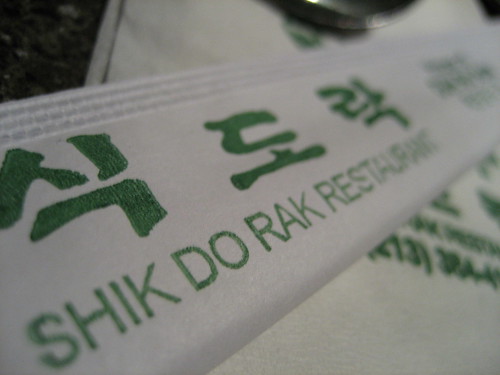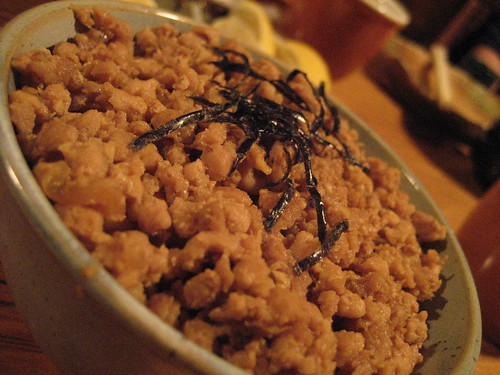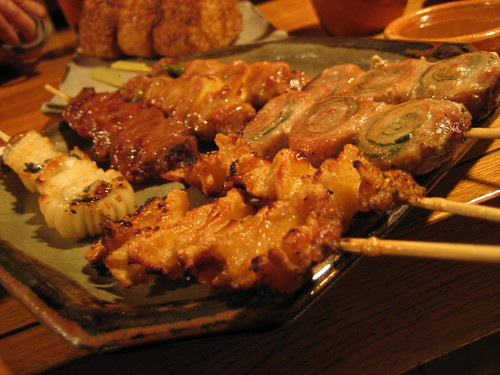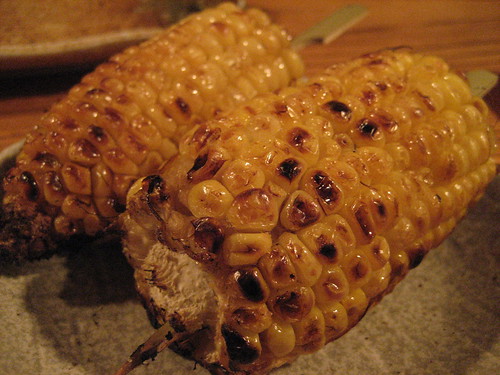Thursday, November 15, 2007
Now I'm One Of "Those" Girls
Please do not decide to go to the bathroom after I had already gone in there and pee'd out my roasted asparagus lunch. And please do not come out of your stall right when I'm trying to do a rush hand washing job so as to not reveal myself as the "stinky pee girl." That's not nice.
Hugs,
DG
Sunday, September 23, 2007
Puerto Rico: A Brand New Flava In My Ear

Ah September.
This September is particularly important to me because it marks A) the fact that my husband and I have survived one year of marriage without killing each other and B) the fact that in a year, we haven't taken any sort of vacation. Those two facts combined was enough reason for us to pack our bags and head eastward to my husband's native Puerto Rico.
They call the island "La Isla Del Encanto" (The Island Of Enchantment) and after a visit of only a week, I can see why. Because after that one week, there are many things I miss about it already. I miss that all its buildings, no matter if in wealthy community or in a not-so-wealthy one, are painted in colors that make you think of ice cream and salt water taffy. I miss the singing of the coquí, a type of tree frog native to the island, at night. I miss the warmth and hospitality of my in-laws and everyone else that I met. And the food...
Yes, I miss the food dearly.
Until last week, my understanding of Puerto Rican food has been based on four meals: two good but very limited meals from a Puerto Rican cafe in Maui of all places and from my husband's grandmother, and two bad ones from a couple of half-assed but rare-to-come-by Puerto Rican-slash-Mexican-or-pan-Caribbean joints here in the Southland. Until last week, my knowledge of Puerto Rican food was limited pretty much to pasteles, a dish similar to tamales but made with plantains instead of corn masa and wrapped in a banana leaf instead of a corn husk, and arroz con gandules (rice with pigeon peas). But after my trip, my experience with Puerto Rican flavors expanded in a big way, and I was lucky enough to taste it both the home-cooked- and restaurant-cooked way.
So what is Puerto Rican food like? Well first let me show you where and what I ate...
Mami's (a.k.a. my Mother-In-Law's) meal of carne mechada, arroz y habichuelas, amarillos, and guineos en escabeche could not have been any more comforting after a long trip out from the mainland. Beef braised with potatoes, green olives, onion and tomato paired with Puerto Rico's "daily bread"--medium-grain rice with a nice hint of oil, stewed pink beans, and sweet plantains--warmed and soothed the soul despite heat and humidity that made one feel like they were breathing hot mud.
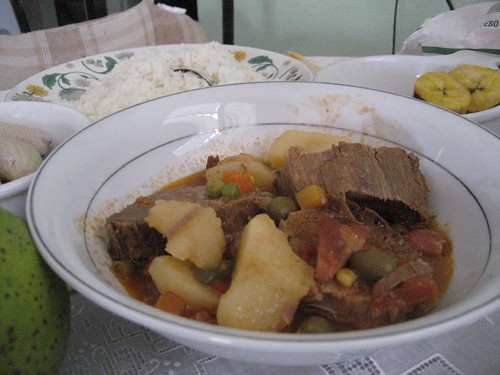
A dish that I'd never heard of was guineos en escabeche, a dish of green bananas marinated in oil, vinegar, onion and garlic. Both filling and slightly refreshing from the unripe banana flavor, this is a dish that has a definite acquired taste.
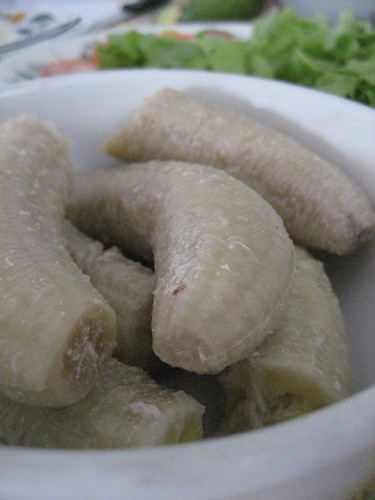
Mami's arroz con salchichas, or rice with vienna sausages, was downright ghetto, and I loved it. How many times have I thrown Spam and corn together to make fried rice? How many times did my Grandma slice hot dogs up and throw them into her fried rice? How do you think kimchi bokum-bap was created? The same way arroz con salchichas was invented, I'm sure. I gobbled this up, along with a delicious pastel filled with tender pork and a pastelillo, an empanada-like pastry filled with a tasty ground beef and cheese mixture.
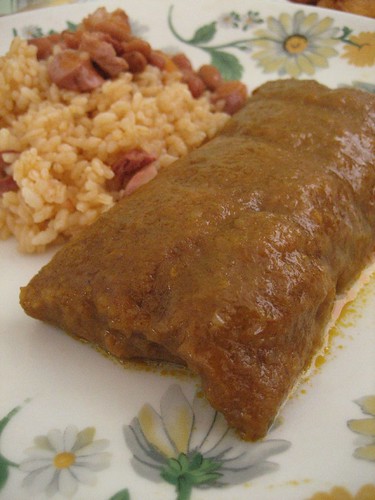 pastel y arroz con salchichas
pastel y arroz con salchichas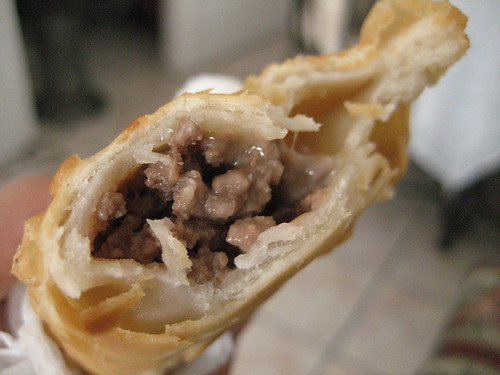
My husband and I stayed in Isla Verde, a beachy area near the airport that's densely packed with hotels and tourists. I think it's where alot of Caribbean cruise goers make their layover, hence the abundance of tourist trappy chain restaurants such as Ruth's Chris Steak House and Momoyama in the area. For us, however, it was pretty much all about roadside food, and in Puerto Rico, there is definitely no lack of it. We ate at Bebo's BBQ one night, drive-in like joint located in Carolina right alongside the highway. We were the only tourists amongst a long line of locals--a good sign if you ask me. For a little over thirteen bucks, we got ourselves three huge plates of food: a half pound of lechon asado (roast pork) roasted so that the meat stayed juicy-tender and the skin had a perfect crackly crunch, one half a pollo asado (roast chicken) also perfectly roasted, some amarillos (sauteed plantains) and a plate of morcilla (Sausage stuffed with blood and rice).
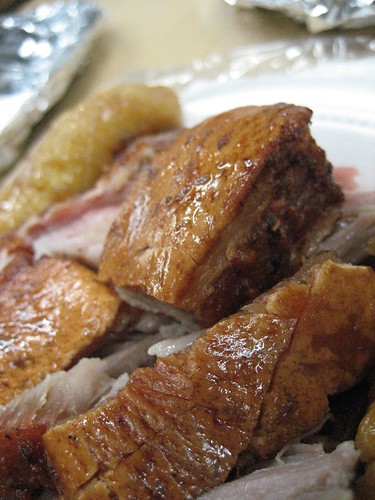
I wanted to like the morcilla--I really did--but it was the intense culantro flavor in the thing that sent me away. Culantro is an herb used frequently in Puerto Rican cooking--an herb that's like cilantro's evil-er twin brother--and those that know me well know that I'll eat pretty much anything--stomach, intestines, blood, liver, kidneys--but nothing makes me gag faster than that vile soapy weed. No offense, cilantro and culantro lovers.
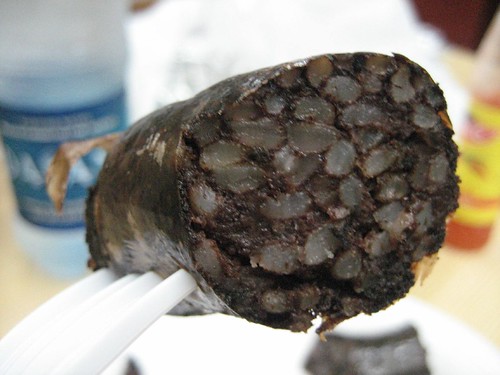
One of the favorite parts of this trip was the drive along the northeastern coast of the island. As we left Isla Verde and headed east into the towns of Piñones and Loíza, there was literally food kiosk after food kiosk on the sides of the road. This had to be unreal, right? Was I dreaming that I could literally stop and get some good, down-home food and snacks, drive off, stop at the beach and play, get back in the car, drive down the road some more, stop at another food kiosk and repeat the process over and over again? If I had been dreaming, I'd never want to wake up. But it was all real. It was not a dream.
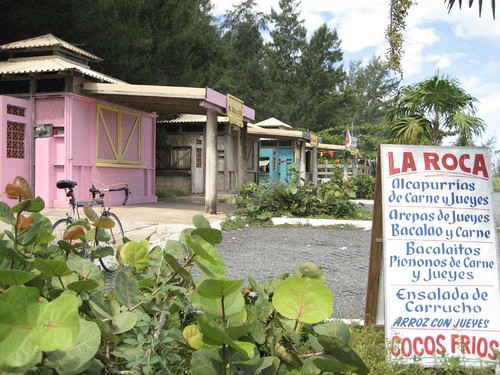
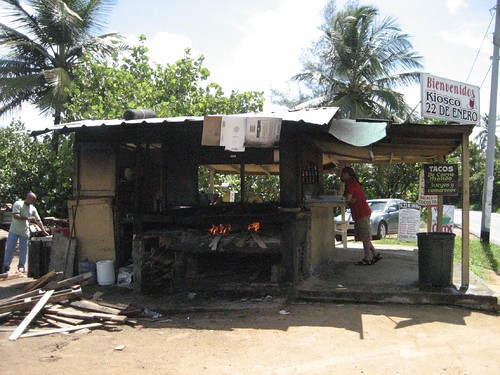
I think it was a good thing that it was still relatively early and that many of these kioskos were not open for business yet, else I would have had to stop at all of them. And then I would have gained 40 pounds solely from all the fried snacks I would have eaten. No, fortunately for me, we stopped at only a few and I perhaps gained only 10 pounds from all the delicious snacks I ate. At any one of these kioskos, you can get mofongo (a dish made of mashed fried green plantains), arroz con jueyes (rice with crab), a variety of seafood cocktails, and best of all, a variety of deep fried snacks. My favorite one was the pionono, made of sweet plantain stuffed with seasoned ground beef and deep fried--so fucking good with its crispy, caramelized exterior that gave way to a juicy interior of both sweet and salty flavors.
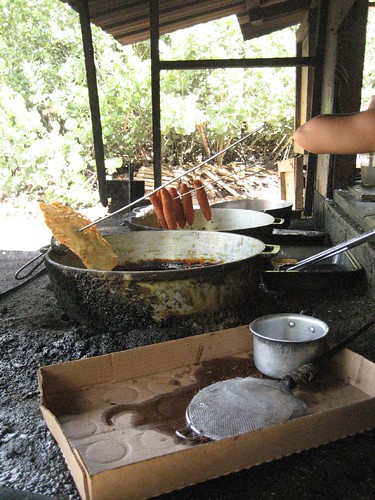
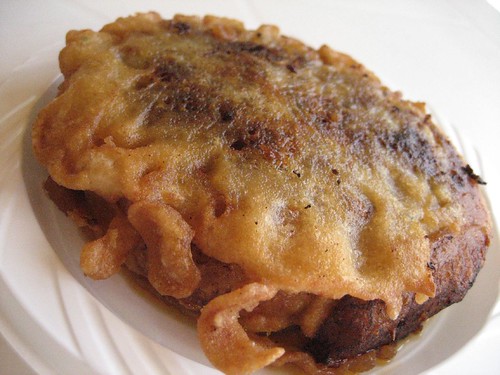
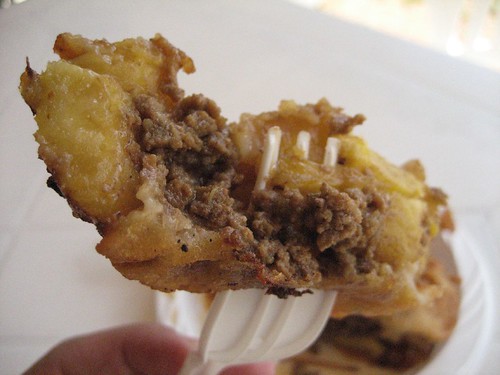
I also loved the popular alcapurria, a fried tube-shaped snack made of a mixture of plantains and yautia and stuffed with meat, in this case, ground beef.

I wish that the place that made my bacalaito, a salt cod fritter and another local favorite, had made it better. The one we had tasted of stale oil and we were just too stuffed to try one from another place.
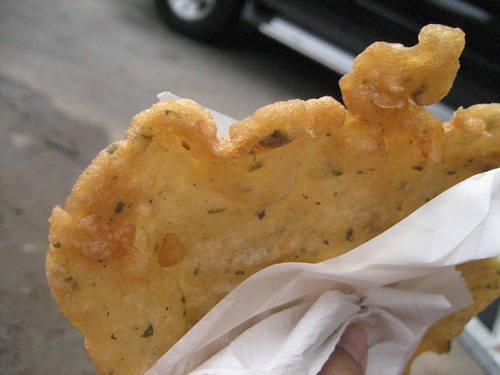
For about a buck more at most of these kioskos, you can add a cup of ice cold mavi, a drink made of the bark of the Colubrina tree and sugar. Definitely an acquired taste, mavi has a sweetish-tartish taste to it and is probably what drinking liquid haw flakes would be like. Sorry, but I think I like my haw flakes better in solid form.
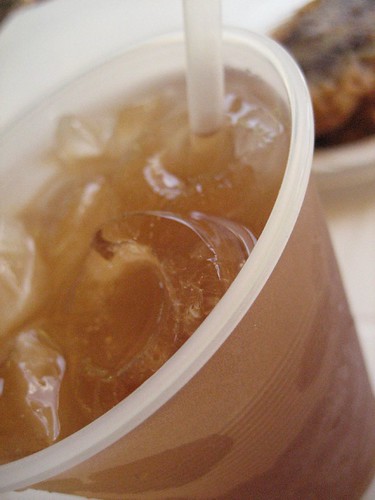
And as if the kioskos in Piñones and Loíza were not enough, there are even more a little further eastward in the coastal town of Luquillo. Here, there is about a three block stretch of end-on-end kioskos selling the same types of foods.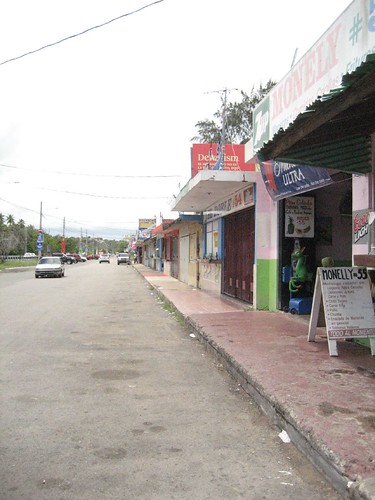
It was here that I tried mofongo for the first time and fell in love. It's a dish made with fried green plantains mashed with garlic, oil and chicharrones, served either with a side of meat or relleno (filled) with some type of meat. I chose to have mine con carne frita, with fried pork chunks. The pork was fried until the meat was a wee bit crispy and until its luscious layer of fat had a nice snap to it. Paired with the garlicky salitiness of the mofongo, I was in heaven.

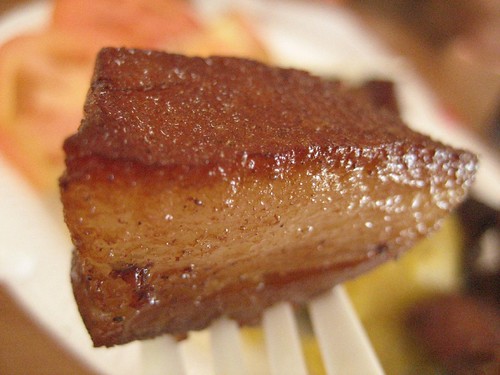
Afterwards, I had some cold coconut water (coco frio) served in a whole coconut to wash it down. Good, but the place we got it from needed to serve it colder.
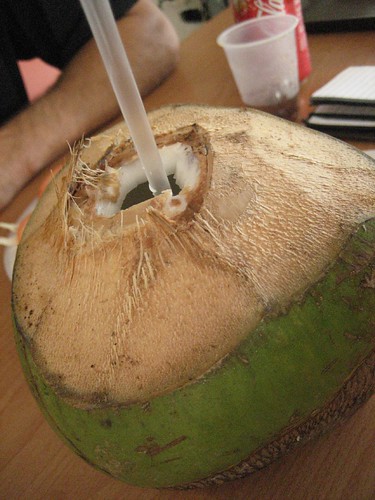
While in Luquillo, we also tried a place called King Seafood that Mami recommended, a place not within the slew of kioskos, but tucked away on another street. It was here that I really discovered how fresh Puerto Rican seafood can be. Though the name in Spanish escapes me, we had these fried mahi-mahi nuggets that were so damn fresh that I almost mistook them for chicken.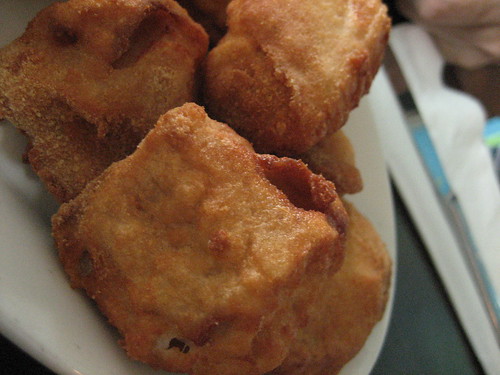
Asopao, a soup made with some sort of meat (in this case shrimp) and rice, was enjoyed by all except yours truly because of its heavy culantro flavor.

Ensalada de pulpo, a cocktail-like salad of octopus, peppers and onions, was refreshing after having eaten so much fried food and red meat and further showcased the island's fresh seafood.
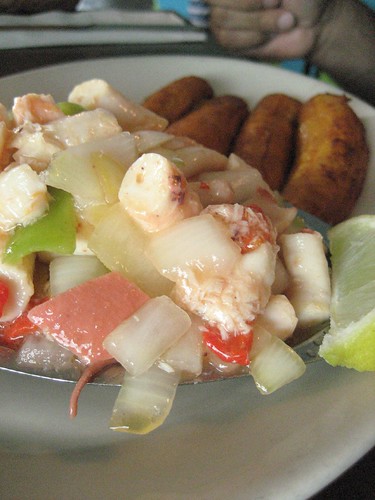
On the side, some tostones, fried patties of green plantain, and sorullitos de maíz, fried corn fritters reminiscent of hushpuppies, were welcome additions to our meal.
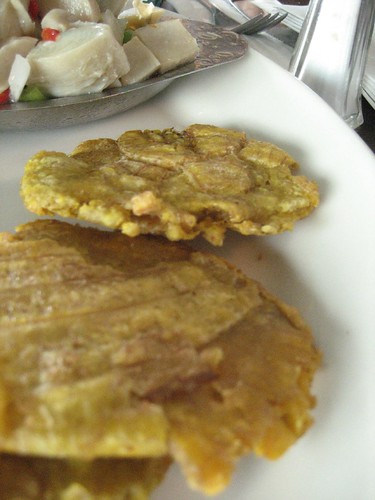
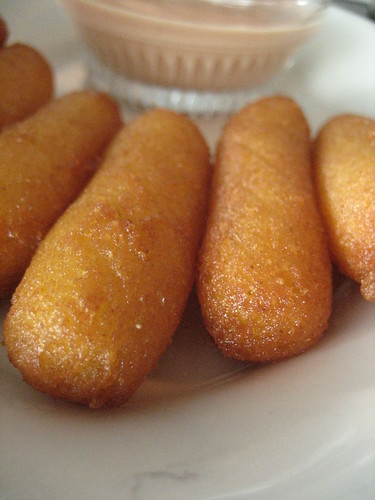
So what is Puerto Rican food like, you ask? From what I know now, it's a cuisine that combines Indian, Spanish, and African influences into a flavor all its own. Fried, stewed and roasted meats are popular and are often served with rice and beans or some sort of tropical starchy fruit/root/tuber such as the plantain or yucca. Foods are generously seasoned, say, with sofrito, adobo, achiote or sazón, but are not spicy in a scotch bonnet pepper sort of way. I could go on and on with my descriptions and observations about Puerto Rican cuisine, but the most important thing I took away was that wherever I ate, whether it was at Mami's house or at some guy's pincho stand on the side of the road, there was alot of heart put into this food...the kind of passion that comes only when one reaches to the depths of one's soul to cook like it's the last time they'll ever cook. That, my friends, is Puerto Rican cuisine.
Saturday, August 11, 2007
Food Of The Conchords: So Hot They're Like A Curry
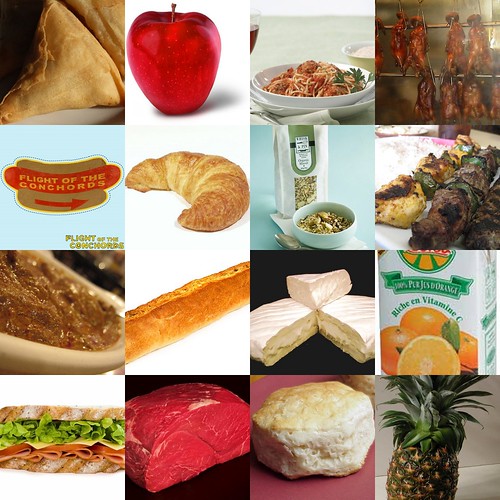 Folk-comedy duos from New Zealand who make me laugh my ass off are pretty cute. Folk-comedy duos from New Zealand who make me laugh my ass off AND who have subtle-but-recurring food themes on their HBO show The Flight Of The Conchords are mother flipping hot.
Folk-comedy duos from New Zealand who make me laugh my ass off are pretty cute. Folk-comedy duos from New Zealand who make me laugh my ass off AND who have subtle-but-recurring food themes on their HBO show The Flight Of The Conchords are mother flipping hot.After only eight 30-minute episodes that have aired thus far, I've heard about talking stoves, animated racist dragons that cry jelly bean tears, Chinese roast duck, samosas, Muesli, lasagna for one, a girl so hot she's like a curry, buying kebabs for a girl who's so beautiful she could be a part-time model, girls and spaghetti, and best of all, croissants and wingmen. It's confirmed: I have a major geeky-crush on these guys. They make me want to do my hair into a flip, throw on my favorite shift dress and go have a carefree picnic in the park followed by a glittery night out at the discotheque.
Don't you wish all trips to le supermarché were this fun?
Flight Of The Conchords
Sundays at 10:30pm , HBO.
(photos--from left to right, top to bottom--courtesy of : wikimedia.org, New York Apple Country, Barilla, answers.com, HBO, frenchfriends.info, Whisk and Pin, Daily Gluttony, Daily Gluttony, Marions Kochbuch, Dominik Hundhammer via wikimedia.org, rouiba.com, Recipes4us, Kansas State University Animal Sciences & Industry, Oregon State University Food Resource, All Creatures)
Sunday, July 29, 2007
Wednesday, June 13, 2007
Cockfight!: Savoy Kitchen Vs. Dong Nguyen, Alhambra

A long time ago in a Chinese province far, far away, someone created a dish that's almost ingenious in its simplicity. Someone took a fat hen, boiled the thing until the meat was plump and tender, and served it on some chicken stock-flavored rice. Someone did this and before you know it, this dish from the Chinese province of Hainan found its way into neighboring Southeast Asian countries such as Singapore, Malaysia, and Vietnam and eventually into the stomachs of those of us who have fallen in love with the simple dish otherwise known as Hainan Chicken Rice.
If you've never had Hainan Chicken Rice before, I suggest you try it because simply put, it's fucking good. OK, OK, so maybe it's not orgasmic good like sushi is or fancy, multi-dimensional good like say, a dinner at Providence, but like I said, it's simple good. It's tasty. It's comforting. It's unoffensive in every possible way except maybe to a vegetarian.
Fortunately for me and my Hainan Chicken Rice cravings as of late, there are two places in my new 'hood that I know of where at least 65% of the diners at any given time are eating this dish. It would only be appropriate, then, that last week, I decided to stage a cockfight: Would Savoy Kitchen's Hainan Chicken Rice rip its opponent from down the street, Dong Nguyen, apart, or would Dong Nguyen show Savoy Kitchen who's boss?
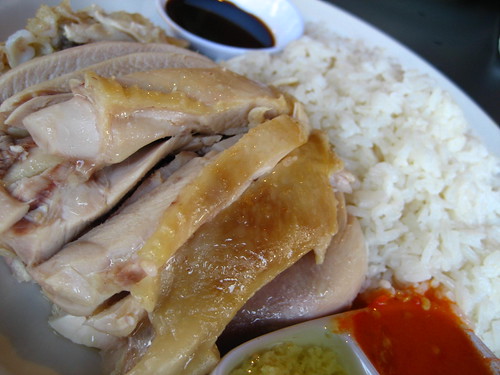

*Ding, Ding!*
Round One: The Chicken Itself.
If there's one thing I can't stand, it's places that serve Cantonese-style boiled chicken, which has more of an al dente bite and where alot of the connective tissue remains, and try to pass it off as Hainan Chicken. Fortunately both Savoy and Dong Nguyen's chicken is boiled until the meat is plump, tender and falling off the bone, both chickens having the slight taste of chicken-y oil, which trust me, is a good thing. Savoy's chicken is cut into larger, cleaner chunks whereas Dong Nguyen's chicken was cut into smaller pieces and had bone shards that kept stabbing the roof of my mouth. The winner? Savoy Kitchen because I prefer bone shard-free eating.
Round Two: The Rice.
I am not kidding when I say that I could eat Hainan Chicken Rice-Rice by itself. If I could, I would substitute the chicken-fat-drizzled or cooked-in-chicken-stock jasmine rice for the white rice that I normally eat with my meals, problem being that I would end up as big as a house. This one was a tie for me. The rice both at Savoy and at Dong Nguyen, being fluffy and full of chicken-y goodness without being too oily, would definitely put me into big, fat house-hood. It was difficult to tell them apart, really. I guess if I had to be really specific then I'd say that Dong Nguyen's rice was a little more chicken-y; Savoy's had more of a twinge of oil and salt. But I liked them both just as much.
Round Three: The Sauces
Say what you will about how much you love the chicken or the rice on your Hainan Chicken Rice, but Hainan Chicken Rice just isn't Hainan Chicken Rice without the dipping sauce or sauces that come with. The Hainan Chicken Rice that I'm used to is typically served with a trio of dipping sauces: one--a sauce of minced ginger and oil, two--a spicy sambal of red chile and lime and three--a dark soy sauce. All three work in unison to add some salty, spicy and even sweet touches to the already delicious dish. Savoy Kitchen's version, which is more true to Singaporean form, comes with these exact three sauces which, because I love them so much, are usually refilled at least once before I'm done.
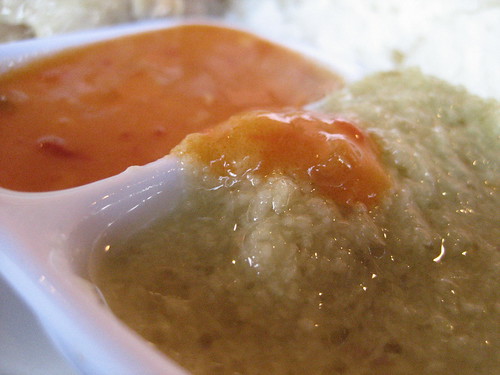
But as with foods like pizza and barbeque, there are also regional differences in Hainan Chicken Rice, which is why I'm assuming that since Dong Nguyen is of Vietnamese/Chiu Chow influence, their Hainan Chicken Rice is served with a sweet, vinegary dipping sauce that's a teeny bit reminiscent of ngoc cham (the dipping sauce that normally pairs with cha gio a.k.a. fried Vietnamese spring rolls) only spiked with ginger and more on the sweet side. The winner? Savoy Kitchen. Savoy Kitchen's sauce trio are true team players that work so well in unison with the chicken and rice, hence the refills. As for Dong Nguyen's sauce, not so much. Although it was markedly different than Savoy's sauces, it just wasn't as nearly as complimentary to the big picture, which is why I hardly used it.
Bonus Round: Atmosphere
This one's a draw too because it just depends on what floats your boat. Savoy Kitchen has an outdoor seating area that's pretty nice on a warm Southern California evening. But it's small and gets really crowded with young San Gabriel Valley hipsters sporting the latest in cell-phone technology (including the very necessary Sanrio cell phone charm), so be prepared to wait for a table. Other menu items include Hong Kong Coffeeshop-style fare such as curries and baked rice dishes and even pizzas and pastas. Service is pretty quick, however, especially if ordering the Hainan Chicken Rice, which the place seems to crank out at factory speed.
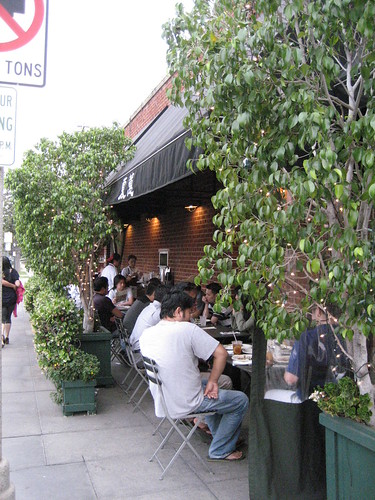
Dong Nguyen is surrounded by 168 Chinese supermarket, a bargain clothing store, and a CVS Pharmacy in an odd strip mall whose tenants have cowboy movie-inspired facades. The atmosphere is virtually zero (which is probably why their Hainan Chicken Rice is twenty-five cents less than Savoy's at six bucks vs. six-and-a-quarter) but the place is clean, and you won't have to wait amongst a crowd of cigarette smoking, D&G-clad twenty-somethings. Go here if you're not in the mood to accompany your Hainan Chicken Rice with pizza since typical Chiu Chow dishes such as hu tieu can be found here instead. Oh, and as opposed to Savoy's street parking situation, there is plenty of lot parking available.
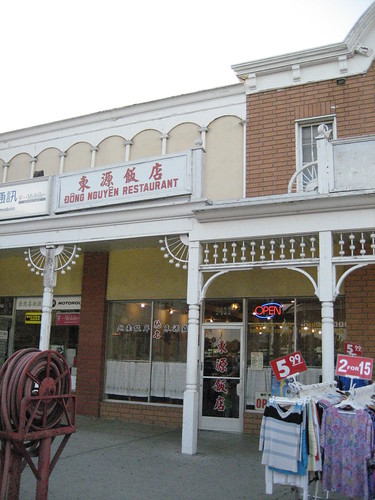
So the winner of this cockfight, not by death or knockout, but by unanimous decision, is...(drumroll please)...Savoy Kitchen! In the end, I just think that Savoy Kitchen delivers a much tighter package with its Hainan Chicken Rice. But that's not to say that Dong Nguyen doesn't put up a good fight. I mean, hey, if I'm jonesin' for some Hainan Chicken Rice and the wait at Savoy is too long, I'm heading down the street and Dong Nguyen wins.
Savoy Kitchen
138 E. Valley Blvd.
Alhambra, CA 91801
(626) 308-9535
Closed Sundays. Cash Only.
Dong Nguyen
1433 E. Valley Blvd.
Alhambra, CA 91801
(626) 300-8618
Closed Thursdays. Cash Only.
Sunday, June 03, 2007
Wild Mushroom Risotto Anyone?

Monday, May 21, 2007
Show Me Some Skin: Shik Do Rak, Koreatown
I love skin.
I love it when it's dry.
I love it when it's wet.
I love it when it's a little bit salty.
I love to lick it. I love to bite it. I love to smack it up, flip it, rub it down...
Now I'm assuming that most of you need to get your mind out of the gutter.
But if you're at all in touch with your Asian side, you'll know that since the Chinese word for food wrapper is also the word for "skin," that I could also be talking about that. You know, like wonton wrappers, er, I mean skins. Eggroll skins. Gyoza skins. Mu Shu skins. Mandoo skins. Xiu Long Bao skins. Burrito skins (aka tortillas) And in this case, I am.
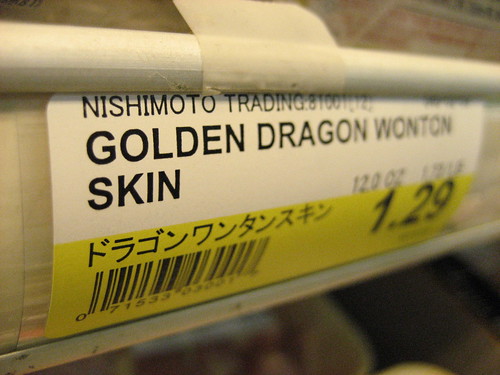 See what I mean?
See what I mean? From what I hear, as far as a certain type of Korean skin is concerned, Shik Do Rak in Koreatown is apparently the self-proclaimed Home-Of-It.
And so it was that Mr. DG and I met up at Shik Do Rak with our favorite foodblogging couple, Jeni of Oishii Eats and Dylan of Eat, Drink, & Be Merry to see what this skin was all about. No, I'm not talking about Korean burlesque, you naughty little minxes. No, no, I'm talking about duk bo sam, otherwise known as Korean rice wrappers.
The process at Shik Do Rak is pretty simple. Grill up your meat. Dip it into the delicious garlicky, beany, red pepper paste and/or into the salted oil. Put it onto a square of duk bo sam. Top with some of the flavorless-needed-to-be-dressed lettuce salad. Wrap it up. Eat. Repeat. Have some of the not-too-plentiful panchan and some Hite beer while you're at it. Shik Do Rak's menu isn't all too complicated either with its handful of meat choices and just a sprinkling of other non-BBQ dishes. We did this whole wrap thing with some chadol baegi which are thin, ribbon-like slices of beef (very reminiscent of the beef curls that you see at those Mongolian BBQ places), beef tongue and beef short rib. Making things even easier is the restaurant's super-attentive wait staff: just ask and you shall receive. And if for some strange reason you don't, just ask the ultra-friendly owner--a cute little older gentleman who literally goes to each table to check on them--and you definitely shall receive.
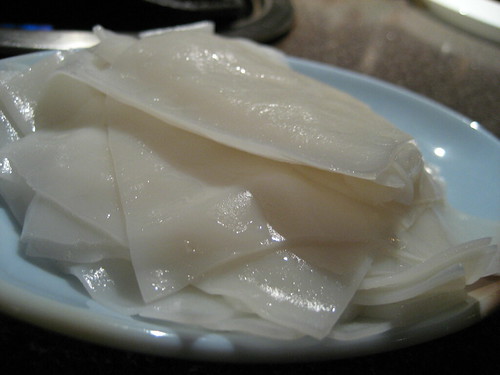
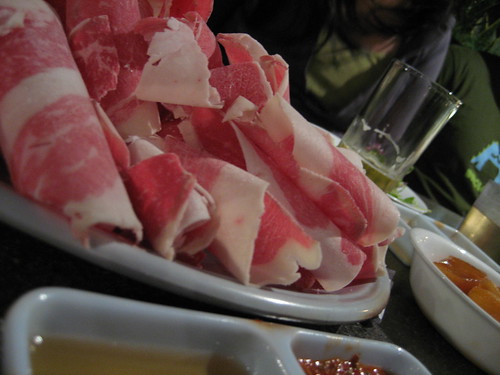
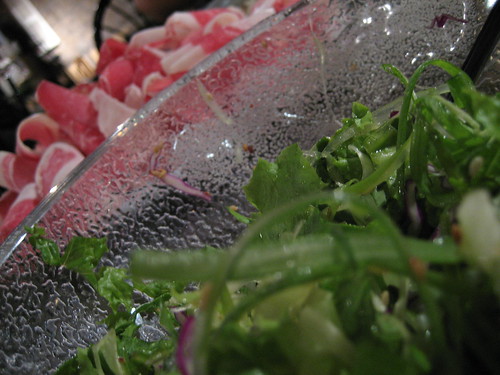 And this...
And this...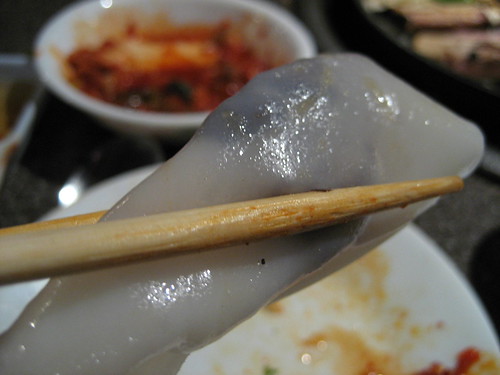
I liked this place, but definitely not because of the meat. Though its overall quality was decent, its flavor left something to be desired because it wasn't pre-marinated. No, my friends, it's all about the duk bo sam here. There's something about the cool, chewy snap of the wrapper against the freshly grilled meat that has one coming back for more. After all, this is the house of skin, er, I mean duk bo sam, isn't it?
Shik Do Rak
2501 W. Olympic Blvd.
Los Angeles, CA 90006
(213) 384-4148
(To get Eat, Drink, & Be Merry's take on our Shik Do Rak outing, go here!)
Tuesday, May 15, 2007
DG's Basement Tapes: Restaurant Koshiji, Little Tokyo
 (This post is the first in a series of gawd-knows-how-many unfinished posts I have hidden deep in the depths of my post library. Had I been more on top of it, this post should have been published in December.)
(This post is the first in a series of gawd-knows-how-many unfinished posts I have hidden deep in the depths of my post library. Had I been more on top of it, this post should have been published in December.)There are Los Angeles foodbloggers.
And there are San Diego foodbloggers.
And there would certainly come a time for the two to meet. So when Kirk, our beloved foodblogger from San Diego, emailed me to tell me he'd be in town, I arranged a mini get-together of local bloggers for the two groups so co-mingle. But somewhere in that fucked-up, obsessed-with-Bizarro-mind of mine, I couldn't help but think of the "Bizarro Jerry" episode of Seinfeld where Jerry, George and Kramer finally come face to face with Elaine's new friends who bore an uncanny resemblance to her OG chums. What if, despite so many similarities most of which revolve around our common passion for food, we had absolutely nothing to talk about once we met up? I imagined uncomfortable moments of silence, obligatory questions like "So...I hear it's going to rain this weekend" followed by "Uh yeah. Mm-hmm" and twiddling thumbs.
Fortunately, however, our Bizarro meet up was far from boring. On a Saturday night, some of us Angeleno foodbloggers--Oishii Eats, Eat, Drink, and Be Merry, Best of LA, Rick James/Diet Chili Cheese Fries, and myself--came face-to-face with Kirk and fellow San Diegan food fiend Jack at Little Tokyo's Restaurant Koshiji. I don't think there was one odd moment of silence as we all had so much to talk about; this was the first time meeting and/or hanging out with Kirk for some of us but it felt as though all of us had known each other for years. I'm really glad to have added Kirk--such a funny, kind and caring person--to my growing circle of food-loving friends.
Unlike its loud & trafficky Bizarro twin Kokekokko down the street, Koshiji is more of a low-key yakitori joint. Service can be extremely slow which could swing the pendulum on meetups like ours either way: either it could make things even more uncomfortable if say, the foodbloggers from the other side of town really are like Bizarro Jerry, or in our case, it gave us more time to chat over the good chow we've had in recent weeks and drool over Kirk's recent experience atUrusawa.
Small cups of raw vegetables with a small dish of miso-based dipping sauce seem to be included with each person's place setting; a much welcomed snack while we waited for our server to take our order and bring us our food, but unfortunately not quite enough for people like ourselves who were starving.
Finally, our food started to arrive. Although we all ordered separately, our food came out very much un-separately, so it took some investigating to remember who ordered what and in what quantities. Luckily, one of the things Isaac and I ordered was Koshiji's chicken yakitori course, so those skewers had been separated from the rest of the pack.
The chicken-on-a-stick course was on the whole, unimpressive. The plain ol' poultry meat skewers--negima (chicken w/ green onion), tsukune (chicken meat ball), sasami (chicken breast with shiso leaf), kamo (duck breast w/ miso sauce) and tebakara (chicken wings)--though not bad, didn't have that just-came-off-the-grill caramelized and smoky wow-factor that I was looking for. My favorite part of a yakitori meal, however, comes not so much from the chicken-meats-on-a-stick but rather from the chicken-parts-on-a-stick. While the liver skewer was just plain gross, the crunchy-textured sunagimo, or chicken gizzard, skewer was pretty damn good as were the cute little quail-eggs-on-a-stick, better known as uzura.
Our yakitori chicken course came with a bowl of soboro-don, a hearty bowl of seasoned ground chicken with egg over rice, and a small cup of broth with...cilantro???? Koshiji lost major points with me right there--what person in their right mind puts cilantro on Japanese food? The soup was given straight to Isaac. He loved it. Enough said. As for the soboro-don, I thought it was a little on the bland side, not quite as tasty as the one I'd had down the street at Kokekokko.
Koshiji was able to redeem itself with some of its other menu choices, however. Their chicken karaage, probably the only non-food-on-a-stick item we ordered that night, was crisp on the outside, tender on the inside and had nice hints of soy and ginger. We almost mistook our kaori (pork belly) wrapped around subtley spicy shiso leaf for grilled mushroom caps upon first glance, but fortunately figured out that they were not someone else's grilled funghi dish. Grilled spirals of squid (ika), scored for even more textural interest and wrapped around shiso leaf, were also delicious. Toumorokoshi (sweet corn) were charred in just the right spots. And with our orders of what are probably my two favorite meat-on-a-stick of all time--crispy kawa (chicken skin) and salted-just-right tan (beef tongue)--koshiji certainly did not disappoint.
All in all, despite the slow service and a couple of misses on a few of their items, Koshiji is a welcome addition to my Little Tokyo dining list. I liked that it was chill, and the awesome company made it that much more fun. Of course if I were Elaine Benes, I'd be forced to choose sides--hang with my OG LA foodbloggers or my newly found San Diego ones. But this isn't Seinfeld after all, and it's good to know that I can hang with both. In the same room. At the same Bizarro restaurant.
Restaurant Koshiji
123 S. Onizuka St. #203 (in Weller Court)
Los Angeles, CA 90012
(213) 626-4989
Monday, May 07, 2007
Eating My Way Thinner: Hijiki Nimono

It sucks trying to eat healthier.
Because suddenly, I don't want to snack on almonds or fruit. I want cookies and chips. I don't want to simple give my pan a small drizzling of olive oil. I want to brown my food in lots and lots of butter and then deglaze the hell out of it with lots and lots of wine. I don't want whole wheat bread. I want tortillas made with lard.
I struggled with many food ideas, looking at recipes from Cooking Light and other healthy eating sources. But the more of these types of recipes I thumbed through, the less appealing they all started to sound with their reduced fat mayo or skim milk substitutions. Not that that's all bad. It's just that sometimes, especially when you're willing to make a big change like this, you want the real deal.
Which is exactly why I went knocking on Japan's culinary door for diet inspiration. I've always admired that Japanese cuisine in its truest form can be so absolutely interesting in taste, texture and presentation without being drowned in huge portions or a ton of oil and fat. I figure that it's better to satisfy myself via sensory overload than by stuffing myself, right?
Unfortunately, this eating-more-Japanese-food-business would have to exclude some of my favorite deep fried Japanese goodies such as menchi katsu, kabocha korokke, chicken karaage and kaki furai. (I'll save those for an occasional weekend treat) But with the huge variety of other healthy foods available, I think I'll be OK.
I always look forward to getting little mounds of hijiki nimono, or simmered hijiki seaweed, either at Japanese restaurants or at the prepared foods section of Mitsuwa market, so I thought, "Why not make this myself?" With a little help from Kimiko Barber's The Japanese Kitchen (a really informative book with gorgeous photos, by the way) I was one step closer to a tasty meal and a healthier physique.
Unless you've tried it yourself, it's hard to get an accurate picture of how hijiki nimono actually tastes but I'll try my best. Texture-wise, the black strips of hijiki are not nearly as thin or slippery as wakame seaweed; I think that they almost have the texture of simmered or steamed carrots with a slightly different bite, which is quite interesting given that there are shredded carrots partying right alongside the hijiki in this dish. Taste-wise, it's a little bitter-sweet, and compliments the saltiness of the soy sauce and the sweetness of the sugar and mirin that it soaks up during the cooking process very nicely. All the ingredients used in this recipe can easily be found at any Japanese or Asian market.
Hijiki Nimino
(adapted from Kimiko Barber's The Japanese Kitchen)
1 oz. dry hijiki seaweed
1 sheet aburage (deep fried tofu)
1/2 cup shredded carrot
3/4 cup konbu dashi (vegetarian kelp broth-see recipe below) OR water if you're short on time
4 tbsp soy sauce
3 tbsp. sugar
2 tbsp. mirin
-Soak the hijiki in hot water for about half hour then drain.
-Put the aburage in a strainer & pour boiling water over it to remove the oil and cut into shreds.
-Put the reconsituted hijiki, tofu shreds & carrots in a pot. Add the konbu dashi or water, soy sauce, sugar and mirin.
-Cook on low heat until all the liquid is absorbed.
Konbu Dashi (Vegetarian Kelp Broth)
1 postcard sized piece of dried konbu (kelp)
4 cups water
-Make a few tears in the konbu and soak it in the water for a several hours. That's it.
I enjoyed this delicious hijiki nimono sprinkled with a pinch of toasted sesame seeds and a little steamed rice and edamame on the side. As opposed to many of my gluttonous meals, there was no bloating afterwards, making this particular meal that much better.
Note: The United Kingdom, Canada, Hong Kong and New Zealand have all issued warnings that traces of inorganic arsenic have been found in hijiki. I'm not sure what to make of this since anything with the word "arsenic" in it is due to sound kinda unappetizing, if ya know what I mean. But I figure that a little hijiki here and there won't hurt since this type of seaweed, until recently, has always been touted for its health benefits and since Japanese people, who by the way are known for their longevity, have had hijiki in their diets for years. As with any food, moderation and variety are key. If you're curious about this whole inorganic arsenic schtick though, you can read about it here, here, here, or here.
Sunday, May 06, 2007
Does "Quarterly Gluttony" Have The Same Ring?

Look at me, I'm all growed up now.
I was just a wee caterpillar, but over the last three months, I wanted so badly to turn into a butterfly.
Only I would have turned into an old, fat, poor butterfly real soon if I didn't watch it. Because in the last three months:
Number One: The Gluttony Family, including our very dear gastro-gnome George, moved into our new home in Alhambra. Being a homeowner is great; not being able to spend as much on food as we did in our renting days is not.
Number Two: I've gained weight.
There, I said it.
Not a ton, maybe somewhere in the vicinity of 5-7 pounds. Enough to make my jeans feel really snug and enough to make me thankful that the babydoll and tunic trend is back in full force.
I am therefore officially on a budget and a diet. I don't really have a set plan; I don't believe in gimmick diets where you're suddenly not allowed to eat any one form of food (Cut all bananas from your diet and lose ten pounds in as little as three weeks!) so I'm relying on the tried and true method of eat less and exercise more, while at the same time treating myself to new restaurants or full-on calorie-packed recipes on the weekend so that I don't shrivel up and die. As things start to settle down and as I have a little more time to dedicate to blogging (with emphasis on the word little--I'm still really busy you know), I'm hoping that you'll follow me on my spending-less-while-eating-healthier path.
If not you can fuck off.
See you soon.

